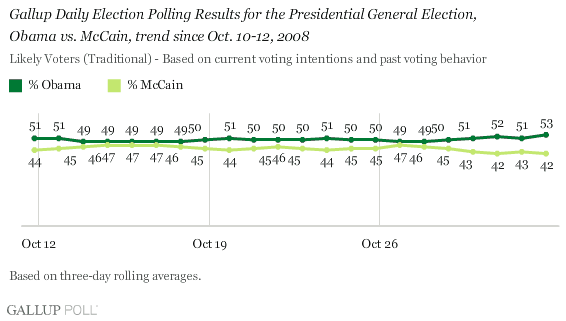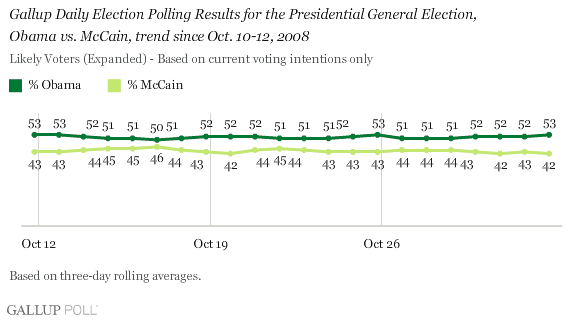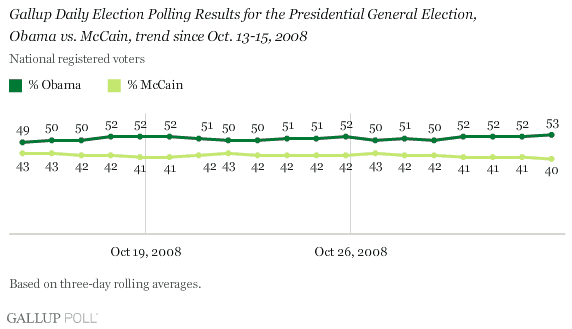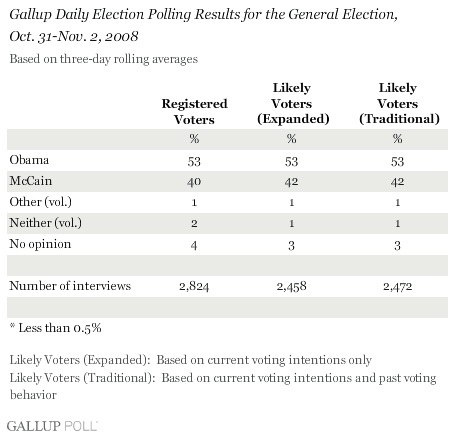PRINCETON, NJ -- The final Gallup 2008 pre-election poll -- based on Oct. 31-Nov. 2 Gallup Poll Daily tracking -- shows Barack Obama with a 53% to 42% advantage over John McCain among likely voters. When undecided voters are allocated proportionately to the two candidates to better approximate the actual vote, the estimate becomes 55% for Obama to 44% for McCain.
The trend data clearly show Obama ending the campaign with an upward movement in support, with eight to 11 percentage point leads among likely voters in Gallup's last four reports of data extending back to Oct. 28. Obama's final leads among both registered voters and likely voters are the largest of the campaign.


Gallup's final estimate is based on Gallup's traditional likely voter model, and assumes an estimated turnout of 64% of the voting age population, an increase over 2004. (Gallup estimates voter turnout from the results of key voter turnout questions, using a model that compares how respondents' answers to these questions have related, historically, to actual turnout.) This year's higher turnout estimate is fueled by a surge in early voting -- 28% of registered voters in the final poll indicated they had already voted -- and higher turnout among blacks than in any of the last four presidential elections.
Gallup has been calculating and reporting an expanded likely voter model alongside its traditional model over the past month. In the end, the candidate selection estimates of the two models converged, and both show the same unallocated 53% to 42% margin for Obama.
The gap in voter support for Obama versus McCain is slightly wider (53% to 40%) when the vote preferences of all registered voters are taken into account. The likely voter model typically shows a reduction in the Democratic candidate's advantage, as has been the case with Obama this year. Nevertheless, Obama has been able to maintain a significant lead over McCain in recent days, ending in the 11-point lead in the final poll. It would take an improbable last minute shift in voter preferences or a huge Republican advantage in Election Day turnout for McCain to improve enough upon his predicted share of the vote in Gallup's traditional likely voter model to overcome his deficit to Obama.

Democrats have been more energized than Republicans throughout the year. In the final poll 73% of Democrats and Democratic-leaning independents say they are enthusiastic about voting compared to 59% of Republicans and Republican-leaning independents. Additionally, the Obama campaign has appeared to do a slightly better job of reaching voters than the McCain campaign: thus far 39% of registered voters say they have been contacted by the Obama campaign compared, with 33% contacted by McCain's camp.
Democratic Advantage in Party Identification Difficult to Overcome
Obama was able to match McCain in maintaining party loyalty toward his candidacy: 91% of Democrats say they will vote for Obama, the same as the 91% of Republicans voting for McCain. But Obama's 90%-plus loyalty has a far greater payoff than McCain's, given the significant Democratic advantage in party identification -- evident not only in this final poll, but throughout the year. In the final poll, 38% of U.S. adults identified as Democrats, 34% as independents and 26% as Republicans. Among likely voters, the figures are 39%, 31% and 29%, respectively.
Thus, given the Republican deficit in party identification, McCain would have needed a big boost from independent voters in order to prevail. The two presidential nominees -- both of whom owe their primary victories earlier this year to solid support from independents -- waged a fierce battle for the independent vote, but in the final poll independents preferred Obama to McCain by 48% to 43%.
An Obama victory would also owe a great debt to overwhelming support from racial and ethnic minorities. McCain led among white voters, 51% to 44%, but Obama more than made up for that with an 83% to 13% advantage among non-whites, including a 97% to 1% advantage among blacks and a 73% to 24% lead among Hispanics.
According to Gallup's final pre-election polls, the last time a presidential candidate won without winning the white vote was Bill Clinton in 1992. That year George Bush narrowly beat Clinton by two points among white voters, 41% to 39%, with 20% supporting third party candidate Ross Perot. Prior to that, Gerald Ford in 1976 received 52% of the white vote to Jimmy Carter's 46%, but Carter won the election with 85% of the non-white vote.
While only 4% of voters remain undecided in Gallup's unallocated likely voter model, the final poll estimates that a slightly larger 10% of likely voters still have the potential to either change their mind or make up their mind. Even if McCain converts the vast majority of swing voters, victory for him would be highly unlikely since 51% of likely voters say they are certain to vote for Obama compared with 39% who say they are sure they will vote for McCain.

Survey Methods
Results are based on telephone interviews with 3,050 national adults, aged 18 and older, conducted Oct. 31-Nov. 2, 2008. For results based on the total sample of national adults, one can say with 95% confidence that the maximum margin of sampling error is ±2 percentage points.
For results based on the sample of 2,824 registered voters, the maximum margin of sampling error is ±2 percentage points.
For results based on the sample of 2,472 likely voters (using Gallup's traditional likely voter model which identifies likely voters on the basis of current voting intention and past voting behavior), the maximum margin of sampling error is ±2 percentage points. The likely voter model assumes a turnout of 64% of national adults. The sample is weighted to reflect this assumption, so the weighted sample size of likely voters is 1,952.
Interviews are conducted with respondents on landline telephones (for respondents with a landline telephone) and cellular phones (for respondents who are cell phone only).
In addition to sampling error, question wording and practical difficulties in conducting surveys can introduce error or bias into the findings of public opinion polls.
